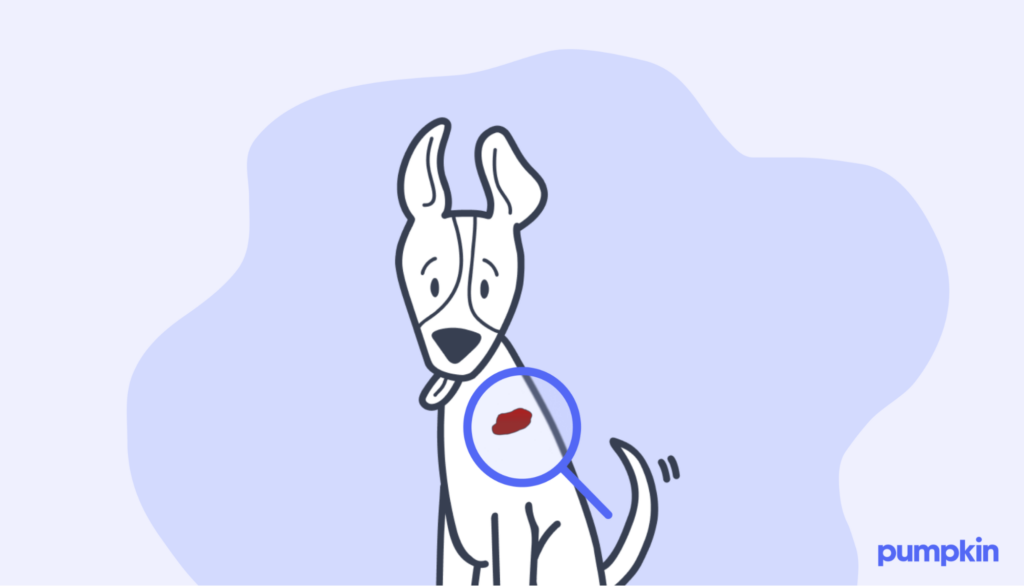Key Points
- Dog skin problems are common and range from mild itching to serious skin infections and sudden growths.
- Symptoms like redness, flaky skin, and excessive scratching often signal an underlying issue.
- Early diagnosis and treatment help keep your dog’s skin healthy and irritation-free.
We often think of fur as our dog’s armor, but underneath, their skin does just as much work. It keeps them protected and healthy — until a problem arises. Whether it’s constant scratching, redness, or signs of infection, skin issues in dogs are both incredibly common and difficult to diagnose at home.
To help you identify trouble spots early, we’ve gathered some information on common skin problems in dogs and their symptoms. We’ll also share some photos of these issues so that you know what you’re looking at. Fair warning — some of these photos are kind of gross.
Remember: As a dog parent, it’s your job to spot the warning signs before they become an emergency.
1. Atopic dermatitis (Atopy)

Just like their humans, dogs can have allergic reactions to food and environmental factors. This results in inflammation of the skin, called dermatitis. Environmental allergens like pollen, mold, or dust can cause inflamed skin, ear infections, and itchy rashes. Food allergies may result in dry skin or gastrointestinal issues. Atopic dermatitis (atopy) often requires a combination of oral medication and topical treatments to soothe symptoms and manage flare-ups.
As with many skin problems in dogs, itching is often the first warning sign. If you’ve ruled out fleas, then talk to your veterinarian about treatment for allergies in dogs.
2. Mange

Mange is very common among rescue dogs and strays (which we like to think of as future rescue dogs). Mange is caused by parasites, specifically mites that burrow into the dog’s skin. It can be mildly irritating to severe. There are two types of mange:
Sarcoptic mange (scabies): This condition is highly contagious to both other pets and humans. Dogs affected by scabies can experience intense itching, crusty bumps, and skin lesions. If left untreated, it can cause widespread infection.
Demodectic mange: This type of mange is caused by mites that normally live on a dog’s skin and are usually harmless. Less contagious, this form causes flaky skin, hair loss, and redness. Puppies or dogs with weakened immune systems are most at risk. Treatment often includes oral antibiotics or topical solutions.
3. Fleas

Tiny but mighty, fleas have been the scourge of pet owners for millennia. Flea bites cause intense itching and can lead to bleeding, scabbing, and hair loss if untreated. These external parasites can also infest homes, creating a problem for both pets and their humans. Regular flea prevention, such as an oral or topical parasiticide, is critical to avoiding flea infestations.
4. Ticks

Ticks are visible but tricky to spot, hiding in fur and feeding on your dog’s blood. These parasites don’t breed and multiply on dogs like fleas, but they can transmit serious diseases. Symptoms of tick-borne illnesses like Lyme Disease include fever, lethargy, joint swelling, and vomiting. Prompt tick removal and prevention products are essential.
5. Ringworm

This contagious fungal infection spreads through direct contact with an infected animal, person, or surface. Symptoms include circular bald patches, scaly skin, and brittle hair. Treatment usually involves antifungal shampoos or oral medication to clear the infection. Like mange, ringworm is common in strays. Also like mange, it’s highly contagious for humans as well.
If you notice ring-shaped rashes spreading on your hands or face after handling a stray dog, you may have been infected with ringworm.
6. Yeast infection

Yeast skin problems in dogs happen when normal skin fungi overgrow, often due to allergies or immune deficiencies. Symptoms include redness, itchiness, a musty odor, and crusty or thickened black skin. Chronic ear infections can also signal yeast issues.
Yeast infections are a common skin condition and typically require topical treatments, along with managing the underlying cause. Fortunately, yeast infections in dogs are not contagious to humans or other dogs.
7. Warts

Warts are small, benign growths caused by the canine papillomavirus. They often show up around the mouth, eyes, or paws, especially in young or immunocompromised dogs. While harmless, warts can irritate your pup if scratched or chewed. If they become infected or bothersome, consult your vet about removal.
8. Hot spots

Hot spots are red, inflamed skin patches caused by excessive licking or scratching. These sores may be oozing, and they may actually be a symptom of other common dog skin problems. Hot spots are often triggered by flea bites, allergies, or stress, these spots can worsen quickly if left untreated. Topical sprays and identifying the root cause can help soothe and prevent future outbreaks.
9. Impetigo
Impetigo, also known as puppy pyoderma, is a common canine bacterial infection. Puppies are more prone to this infection, and it is often seen on the belly as a series of red, raised pimples that may be pus-filled. Sometimes, these raised pimples burst and form scaling. Impetigo is usually mild, and some puppies can clear this infection on their own, while others may need oral antibiotics or antibacterial ointments.
10. Folliculitis

Folliculitis is often caused by a deep bacterial infection of the hair follicles. This bacterial infection inflames hair follicles, causing sores, bumps, and scabs, which usually form on the elbows, hips, or chin. It’s typically triggered by underlying issues like allergies, parasites, or pressure on the skin from lying on a hard surface that irritates the skin. Treatment usually includes medicated shampoos and antibiotics.
11. Immune disorders
Autoimmune conditions in dogs like pemphigus mimic skin infections, causing flaky skin, pustules, and redness. These disorders don’t respond to antibiotics and require specialized care. A vet may recommend immune-suppressing medications or topical treatments to manage symptoms.
12. Tumors and cancer

Few dog skin problems are scarier than sudden lumps, which many pet owners associate with cancer. However, not all lumps are cancerous, though skin lesions or unusual growths should always be examined by a vet. Common in older dogs, benign fatty tumors (lipomas) are often painless but can be removed if they cause discomfort or restrict movement. Whenever you notice a new growth or lump on your dog’s skin, check in with your vet.
13. Seborrhea
Seborrhea causes flaky, dry skin and can leave the coat greasy or oily. Severe cases may emit a foul odor and result in thickened skin. It is an inherited skin disorder linked to allergies, infections, or hormonal imbalances. This condition is commonly treated with medicated shampoos.
14. Alopecia
Alopecia, or hair loss, appears as bald spots, thinning hair, or complete hair loss. It’s often accompanied by redness, flaky skin, or open sores. Causes of alopecia in dogs include allergies, parasites, hormonal imbalances, or overgrooming. Preventing further irritation and addressing the root cause can help restore your dog’s healthy coat.
Spotting these skin issues early lets you work with your vet to keep your dog comfortable and on the path to healthy skin.
Signs of dog skin problems
Your dog’s skin can say a lot about their overall health. Knowing the signs and causes is the first step to finding relief for your pup. When something isn’t right, you might notice:
- Excessive scratching, licking, or biting
- Redness, swelling, or visible irritation
- Hair loss or bald patches
- Flaky, scaly, or dry skin
- Scabs, bumps, or sores
Diagnosis and treatment

When it comes to dog skin problems, diagnosing the issue isn’t always straightforward. Many conditions — like dermatitis, fungal infections, and parasites — can share similar symptoms, making it tricky to pinpoint the exact cause. Your vet may start with a thorough skin exam and might use tools like skin scrapings or allergy tests to get a closer look.
They’ll also want your help in piecing the puzzle together. For example, are there any new products in the house? A recent hike in the woods? These little details can be big clues.
Depending on the diagnosis, treatment options might include soothing shampoos, topical sprays, dietary supplements, or oral medications. Your vet will create a tailored plan to get their skin back to normal.
When unexpected health problems arise, vet bills can add to the worry. That’s where Pumpkin Dog Insurance plans come into play. Pet insurance provides coverage for eligible vet bills in the future, meaning you can focus on getting your pup the care they need and not on the cost.
FAQs
- https://www.akc.org/expert-advice/health/mange-what-you-need-to-know/
- https://www.vet.cornell.edu/departments-centers-and-institutes/riney-canine-health-center/canine-health-information/fleas
- https://www.akc.org/expert-advice/health/yeast-infections-in-dogs-what-to-know/
- https://vcahospitals.com/know-your-pet/pyoderma-in-dogs
- https://www.animalfriendsdermatology.com/site/blog/2024/03/29/folliculitis-dogs
- https://www.vet.cornell.edu/departments-centers-and-institutes/riney-canine-health-center/canine-health-information/canine-skin-autoimmune-diseases
- https://www.msdvetmanual.com/dog-owners/immune-disorders-of-dogs/immune-deficiency-diseases-in-dogs#Deficiencies-in-Phagocytosis_v3205008
- https://www.merckvetmanual.com/dog-owners/skin-disorders-of-dogs/seborrhea-in-dogs




